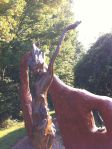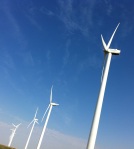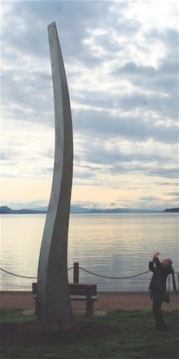
The Children’s International Peace and Harmony Statue
Finally – a bit of clear time to write a final post about the 2012 road trip that took us from Nova Scotia through to New Brunswick, Prince Edward Island, and Quebec, and then through about 20 states (Vermont, New Hampshire, Massachusetts, New York, Connecticut, Pennsylvania, Maryland, West Virginia, Kentucky, Indiana, Illinois, Missouri, Kansas, Oklahoma, Texas, New Mexico, Arizona, Nevada, California, Oregon and Washington.) I said it in my first posting when I returned home, but I need to say it again: It Was The Trip Of A Lifetime! So many wonderful people….
Now — the thing that (perhaps) sums it all up….
We had long dreamed of a road trip across rural parts of America, but what made it a reality for us was the opportunity to personally collect a piece of sculpture that had been generously donated to Deryk’s Peace Sanctuary Sculpture Park in Northern BC. http://peacesanctuarysculpturepark.org/
The trip gave us a chance for both new learning and closure — things that would have been missed had we done the more obvious thing and had the work professionally shipped to its destination. We are extremely glad that we made the trip. Over the years we had made connections with people through email and phone calls, and this was our chance to meet them in person.
So, my earlier posting about our car – which took a lighthearted view at what was involved in getting the sculpture from Indiana to our home (it isn’t at its final location yet) – tells a bit of the story of just how we approached the physical part of the process.
But this posting (much more difficult to write) is to talk about the significance of art we encountered on our trip, especially the sculpture that we will eventually take to the northern part of BC.
How, you might ask, did a large bronze sculpture come to be donated from Laconia Indiana to eventually end up near Fort St John BC? It’s a long, complicated story that started well over ten years ago and began with our children’s book about peace (Echoes from the Square), a story that took place in the then war-devastated city of Sarajevo and featured a cellist whose music gave hope to that city. Our book connected us to a boy named Jason Crowe in Indiana whose journey throughout the project has been truly amazing. Jason worked to raise funds for a sculpture to be created by David Kocka – an artist he greatly admired and whose work, as you’ll see in these photos, has a very special spiritual, inspiring quality.
Jason and David visualized a bronze cellist playing in the square of a peaceful Sarajevo. Part of that dream came true – Sarajevo is now free from war. But there were roadblocks that prevented the sculpture from being realized in the form that Jason had originally wanted. So the sculpture was revisualized as a group of children, playing harmoniously and reaching to each other — “The Children’s International Peace and Harmony Statue”. Ultimately it was decided that the sculpture should stay in North America. It will be on display at the Prince George Art Gallery (BC) and then will eventually be installed at Deryk’s Peace Sanctuary Sculpture Park.
We feel privileged to have had the chance to get to know these people.
Jason is now a young man, and we know that the experience of promoting peace in this way has shown him many aspects of how people interact with each other. We are certain that a love of the arts will continue to be an important part of his life.
We are thrilled that the Peace Sanctuary Sculpture Park will be a showcase for the final result of Jason’s vision. I know that this post doesn’t convey the depth of effort here — the evolving ideas, conversations, challenges, love, frustration and the many many people involved over the years. Hopefully, the sculpture itself contains all of those things and when people see it, they will be able to form an understanding of what it represents.
- Sculpture on roof, ready to drive home
- David and his work
- On David’s property
- sculpture on David’s property
- detail of a David Kocka sculpture (not sure of the title of this)
- David Kocka sculpture: The Children’s International Peace and Harmony Statue
————-
October 24 – adding a quote I had forgotten to include in this post. When the conversation about art came round to the topic of fame, David Kocka said a wonderful thing — that he wanted to be a “celebrant, not a celebrity.”
I love that idea as the reason for making art. Art is a way to share the things we believe are worth celebrating about. I see that in David’s work and thank him for it.










 Posted by Elizabeth Wellburn
Posted by Elizabeth Wellburn 




















